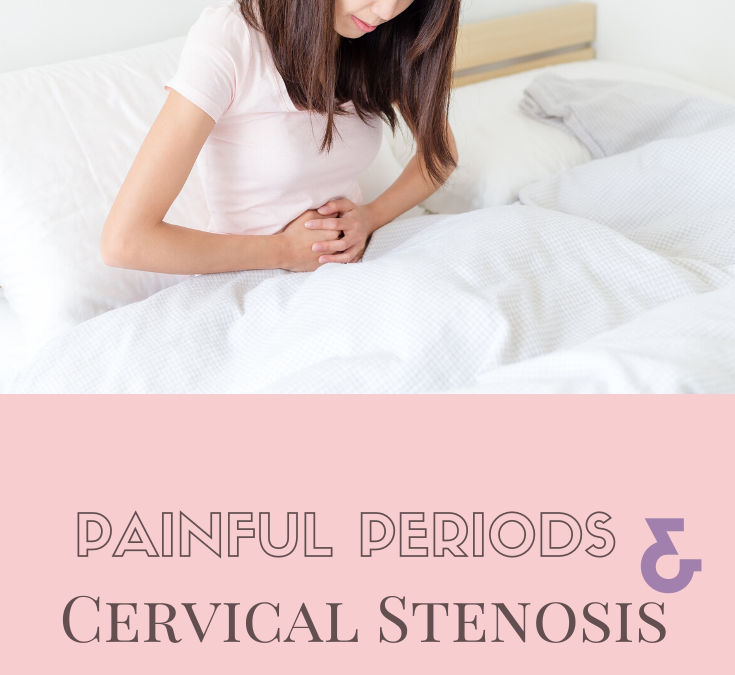Gynecological conditions such as cervical stenosis aren’t well known. Indeed, you can experience symptoms and have no idea that cervical stenosis is the reason. The main reason there’s little known about this condition is a lack of awareness and education. And if that’s not frustrating enough, women with endometriosis may be at a higher risk of developing issues with cervical stenosis. So, what exactly is this condition? How is it diagnosed? And how is it treated?
Page Contents
Cervical Stenosis Explained
Cervical stenosis is a condition in which the passageway through the cervix becomes narrow or closed. Consequently, issues such as irregular periods, painful periods, recurrent pelvic pain, and infertility can arise. Furthermore, it can be present at birth, or it can develop later in life. Various factors increase the risk of cervical stenosis. Common causes include uterine surgeries (i.e., endometrial ablation), cervical cancer, cysts, endometriosis, scarring, and radiation treatments.
How It Impacts Menstrual Health
When it comes to menstrual health, cervical stenosis can cause painful periods and chronic pelvic cramping. This pain and discomfort are caused by the cervical opening becoming so narrow that it’s difficult for menstrual flow to exit the body via the vagina. Additionally, if the cervical opening completely closes, blood can build up in the uterus, thus intensifying pelvic cramping as the uterus contracts to expel it. Which, in turn, increases pelvic pain, inflammation, and period irregularity.
Symptoms to Look Out For
Key signs that may indicate cervical stenosis as an underlying issue include:
- Absent periods
- Painful, disruptive periods
- Abnormal vaginal bleeding
- Infertility
- Chronic or recurrent pelvic pain
It’s important to understand that experiencing these symptoms is not normal. They indicate an underlying issue and are cues that you need to visit your doctor and discuss what’s going on.
Diagnosing Cervical Stenosis
The process involved with having your symptoms evaluated and diagnosed will vary. But generally speaking, your doctor should focus on understanding your symptoms and determine the diagnostic process. I believe that it’s helpful to be body literate and know what’s normal versus abnormal about your body. Furthermore, having a basic understanding of gynecology and reproductive disorders is also beneficial. Exhibiting awareness regarding diseases such as cervical stenosis, and understanding your risk makes you an active participant in your diagnostic process. Additionally, you’ll be able to follow the steps necessary to get appropriately diagnosed, which can ease stress.
Pelvic Examination
There are a couple of ways that cervical stenosis can be diagnosed. The first is to receive a pelvic exam. It’s during this time that your doctor will evaluate the shape, size, color, and texture of the cervix for any abnormalities. If they notice that the cervix opening appears abnormal, they may try to insert a probe to obtain tissue samples. If unsuccessful, they may decide to diagnose you with cervical stenosis. Or, they may require additional testing.
Pelvic Ultrasound
If you’ve discussed with your doctor how you’re struggling with recurrent pelvic pain, they may decide to perform a pelvic ultrasound. This procedure is another way your doctor may diagnose cervical stenosis is to perform a pelvic ultrasound. It’s during an ultrasound in which abnormalities within the uterus are identified. For instance, it’s common for a blood mass, known as a hematometra, to develop within the uterus due to blood becoming trapped in those with cervical stenosis.
Treating Cervical Stenosis
Thankfully, cervical stenosis is highly treatable. Your age, severity of symptoms, and desire to have children are the main factors that determine the best treatment for your condition. For example, if you’re experiencing little to no pain and don’t have severe menstrual abnormalities, you and your doctor may decide to forgo treatment. Whereas, if you’re dealing with intense pain, menstrual irregularities, and you’re seeking to have children discussing treatment options with your doctor will be prudent.
Cervical Dilators
The standard treatment for cervical stenosis is to have a cervical dilator placed within the cervix. This small device works to expand and stretch the cervix over time. If this is a treatment that your doctor is suggesting, make sure you discuss at length the side effects and the long-term impact such treatment will have. Additionally, do your research. Are there aspects of this treatment that make you uncomfortable? Do you have questions about its efficacy? Should you be working with a specialist? Express and discuss your concerns with your doctor before making any next steps.
Outlook
While this isn’t a popular condition that gets discussed a lot, it’s still a common gynecological disorder that causes pain and disruptive symptoms for many women. Furthermore, the lack of awareness surrounding this condition may contribute to it being overlooked, misdiagnosed, and undiagnosed. But, the great news is that it can be easily treated once diagnosed. And, while this post doesn’t discuss the various treatments for cervical stenosis if you have cervical stenosis, you should prioritize conversing with your doctor about a suitable treatment. Lastly, remember that living with painful, irregular, or abnormal periods is not normal or healthy. Treat it as a sign that your body is trying to tell you something and get evaluated to determine the root cause.
References






